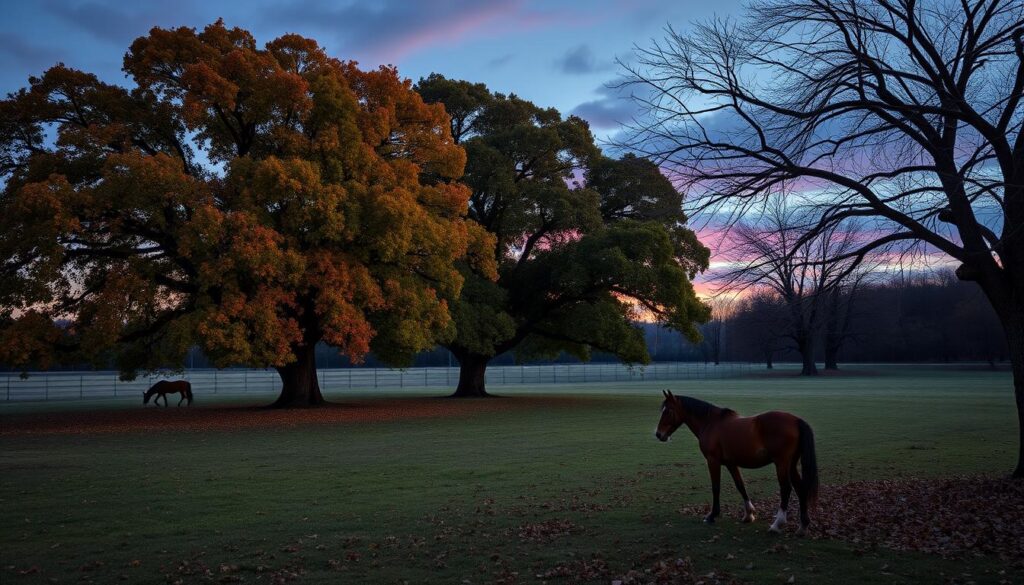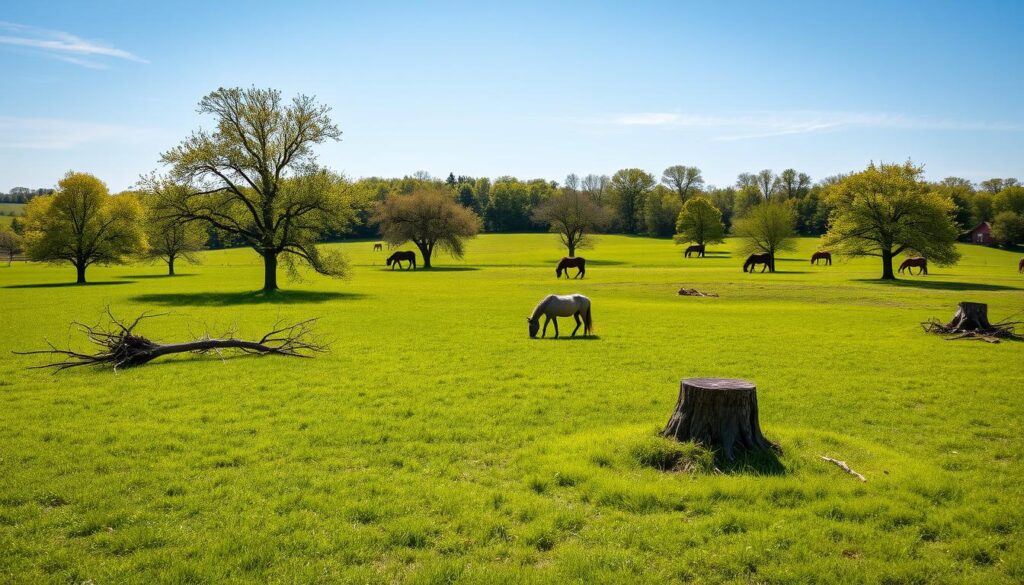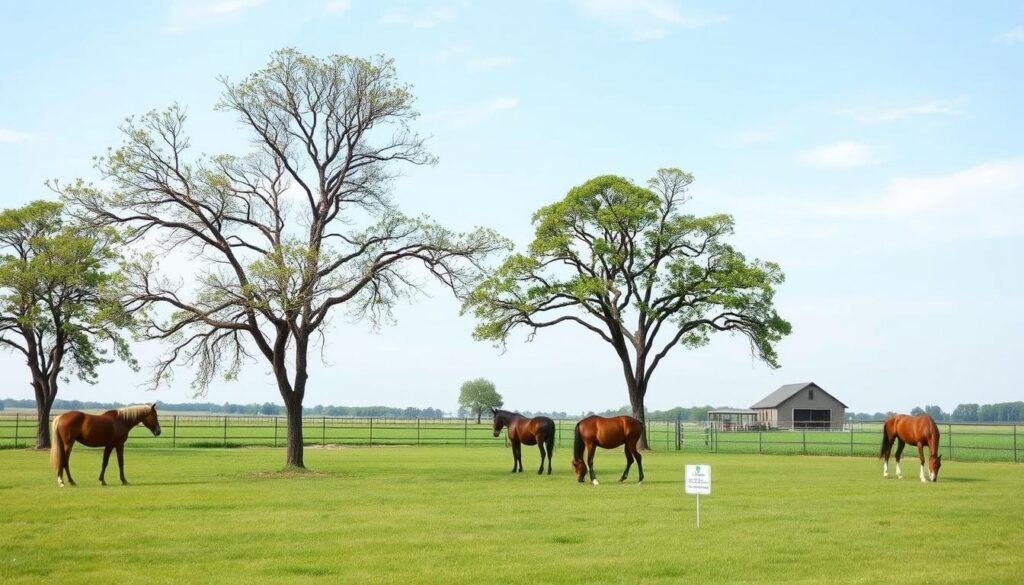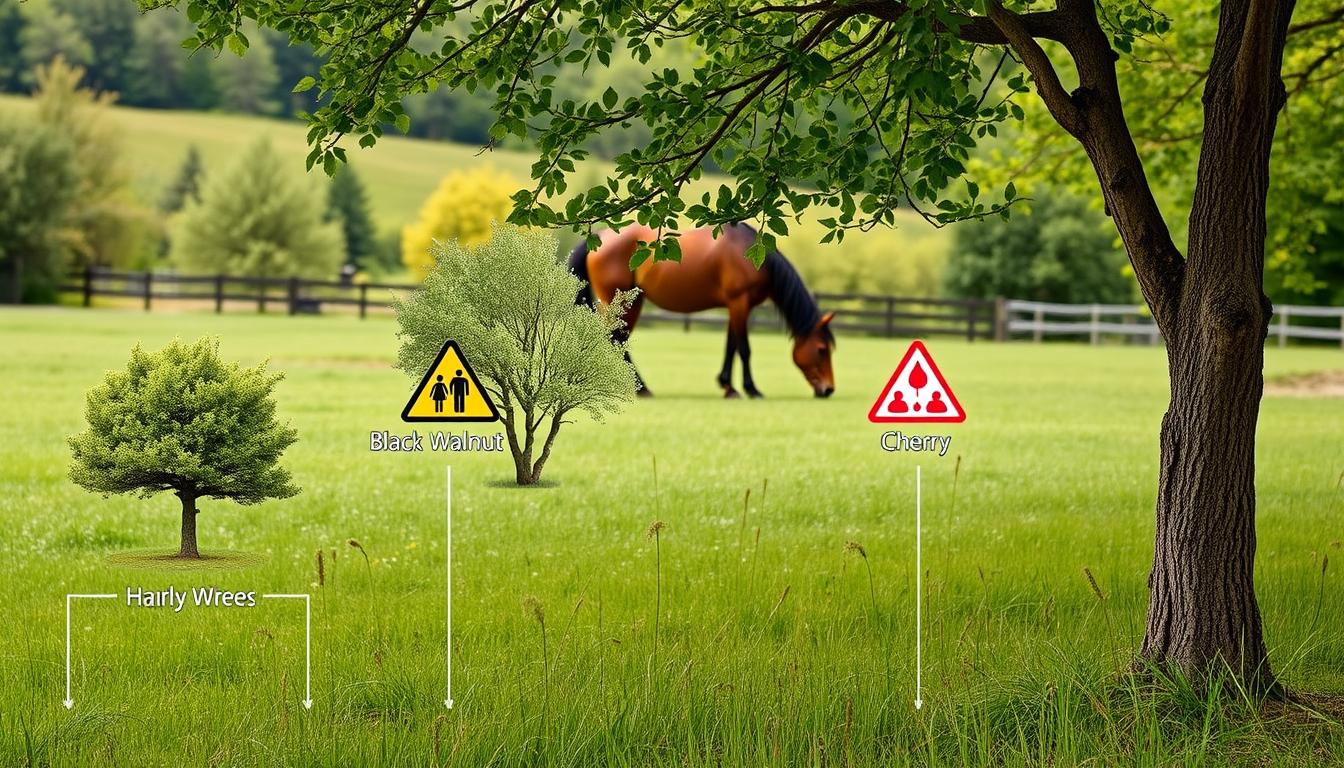As a horse owner, keeping your horses safe is key. This means choosing the right trees for your pasture. Some trees can be poisonous and even deadly to horses. It’s important to know which trees are safe and which are not.
Keeping your horses safe is a big responsibility. The wrong trees can harm them. So, it’s crucial to pick safe trees and avoid the dangerous ones.
Key Takeaways
- Understanding the risks associated with toxic trees is crucial for equine safety.
- Tree selection is vital for maintaining a healthy and secure environment for horses.
- Poisonous plants and toxic trees can pose significant risks to horses, including poisoning and death.
- Avoiding Trees Not to Have in Your Horse Pasture is essential for horse health and well-being.
- Equine safety should be the top priority when selecting trees for your horse pasture.
Understanding the Risks of Toxic Trees in Horse Pastures
Choosing the right trees for horse pastures is key to keeping horses safe. Toxic trees can harm horses and it’s important to know the risks. These trees can cause poisoning or health problems, so picking safe trees is crucial.
Tree selection is vital for equine health because horses might eat toxic parts. Knowing the signs of poisoning is important for quick treatment. Symptoms can include colic, lethargy, and trouble breathing. It’s also key to pick horse-friendly trees that are safe for them.
Why Tree Selection Matters for Equine Health
Choosing trees is not just about looks; it’s about keeping horses healthy. Toxic trees can harm horses if they eat leaves, branches, or seeds. By picking horse-friendly trees, owners can keep their animals safe.
Common Ways Horses Access Dangerous Tree Parts
Horses can get into toxic tree parts in different ways, like eating them or accidentally ingesting them. It’s important to know these risks and prevent them. By understanding toxic trees dangers, owners can protect their horses and keep them healthy.
Signs of Tree-Related Poisoning in Horses
It’s crucial to recognize poisoning signs in horses to act fast and treat them. Symptoms can be colic, lethargy, or trouble breathing, based on the tree and how much is eaten. Knowing these signs helps owners keep their horses safe and healthy with horse-friendly trees.
The Red Maple Threat: Most Dangerous Tree for Horses
The Red Maple is a toxic tree that’s very dangerous for equine safety. Its leaves have a toxin that can harm a horse’s stomach if eaten. It’s very important for horse owners to make sure their land doesn’t have these trees.
Horse owners need to know about the dangers of toxic trees. They should learn how to spot Red Maples, know the signs of poisoning, and have a plan for emergencies. By being careful with equine safety and landscaping for horses, owners can keep their horses safe from toxic trees like the Red Maple.
- Identifying and removing Red Maple trees from pastures and surrounding areas
- Preventing access to areas where Red Maple trees are present
- Monitoring horses for signs of toxicity, such as colic, diarrhea, and lethargy
- Having a plan in place for emergency situations, including access to veterinary care and a list of emergency contact numbers
By focusing on equine safety and being proactive with landscaping for horses, owners can protect their horses from toxic trees like the Red Maple.
Black Walnut Trees and Their Effects on Equine Health
Black Walnut Trees are common in many pastures but can harm horses. The hulls of these trees contain a toxin that can cause laminitis in horses. It’s important for horse owners to know about Black Walnut Trees and their effects to keep their pastures safe.
Keeping an eye on the pasture is key to avoid toxic trees. This means doing pasture management like checking for toxic plants and removing them. By doing this, horse owners can keep their horses safe and healthy.
Identifying Black Walnut Trees
Black Walnut Trees have unique hulls and leaves. They can grow up to 100 feet tall and are found in many parts of the United States. Horse owners should know how to spot these trees to keep their horses away from them.
How Black Walnut Affects Horse Health
The toxin in Black Walnut Trees can harm horses in many ways. It can cause laminitis, colic, and breathing problems. Horse owners need to be careful and prevent their horses from eating any part of the tree. This includes equine health checks and regular vet visits.
Safe Distance Requirements
To keep horses safe, Black Walnut Trees should be far away. Horse owners should remove any trees or plants that are close to their horses. They should also use pasture management to stop toxic plants from growing.
Oak Trees: Understanding Seasonal Dangers
Oak Trees can be dangerous for horses, especially in certain seasons. The acorns have tannins that are toxic if eaten too much. Horse owners need to know about these dangers to keep their horses safe.
Checking the pasture often helps spot risks from different trees. Fall is a key time when Oak Trees drop acorns. Owners should keep horses away from these areas.
Choosing the right trees is important. Look for horse-friendly trees that are safe and provide shade. Some good options include Willow, Apple, and Pine trees.
- Willow trees
- Apple trees
- Pine trees
Knowing about dangers from Oak Trees and others is crucial. By being proactive, owners can make a safe space for their horses. 
Other trees can also be risky for horses. It’s important to know which ones to avoid. By picking horse-friendly trees and watching out for seasonal dangers, owners can keep their horses safe.
Cherry Trees and Wilted Leaf Syndrome
Cherry Trees are a big danger to equine safety because of Wilted Leaf Syndrome. This happens when horses eat wilted cherry leaves, leading to cyanide poisoning. It’s very important to know about these risks to keep horses safe. For more info, check out the horse website.
It’s key for horse owners to know the difference between wild and ornamental cherry trees. Wild cherry trees are often found in pastures, while ornamental ones are in landscaping. Both can be harmful, but wild cherry trees are more likely to be eaten by horses because they’re closer to where they graze.
Wild Cherry vs. Ornamental Cherry Risks
Wild cherry trees are more toxic to horses than ornamental ones. The wilted leaves of wild cherry trees have more cyanide, which can be deadly. Ornamental cherry trees have less cyanide but can still be harmful if eaten a lot.
Recognizing Dangerous Cherry Species
To keep horses safe, it’s important to know which cherry trees are dangerous. Horse owners can prevent Wilted Leaf Syndrome by removing cherry trees from pastures. They should also provide other food and shelter for their horses. By understanding the risks and taking action, horse owners can keep their horses safe from Wilted Leaf Syndrome.
Trees Not to Have in Your Horse Pasture: Essential Checklist
Keeping horses safe is a top priority in pasture management. It’s important to avoid toxic trees that can harm them. Horse owners need a checklist of trees to avoid for their pasture.
Common Toxic Species List
Here’s a list of common toxic trees to avoid in horse pastures:
- Red Maple
- Black Walnut
- Oak Trees
- Cherry Trees
Regional Variations
Tree species and their toxicity can vary by region. Horse owners should research the trees in their area. This helps keep their pasture safe for horses. Knowing the risks and taking steps to prevent them ensures horse safety.
The Hidden Dangers of Yellowing and Fallen Leaves
As the seasons change, yellowing leaves can become a hidden danger to horses. These leaves, especially from certain tree species, can be more toxic than their green counterparts. They can easily be ingested by horses if not properly managed. Understanding the risks associated with fallen leaves is essential for horse owners to take preventive measures.
Regular cleaning of the pasture to remove fallen leaves and monitoring the health of the trees can help mitigate these risks. Horse owners should be aware of the potential dangers of yellowing leaves and take steps to protect their horses’ equine health. This can include removing fallen leaves, avoiding certain tree species, and providing alternative sources of food and shelter.
To ensure the equine health and safety of their horses, owners should be vigilant about the potential risks of yellowing and fallen leaves. By taking proactive measures, horse owners can help prevent accidents and keep their horses healthy and thriving.
Proper Tree Management in Equine Areas
Effective tree management is key to keeping equine areas safe. It means stopping horses from getting to toxic trees. This keeps the animals healthy and happy. To manage trees well, you need good fencing, regular upkeep, and plans for emergencies.
In places for horses, tree management stops them from getting to bad trees. You need strong, tall fences to keep them out. It’s also important to check the area often, remove bad plants, and keep the fences in shape.
Key Considerations for Fencing Solutions
- Sturdy fencing materials to prevent horses from breaking through
- Adequate height to prevent horses from jumping over
- Regular inspection and maintenance to ensure the fencing remains in good condition
With the right tree management, like good fencing, horse owners can keep their animals safe. Regular checks and emergency plans are also crucial. They help avoid dangers and keep horses healthy. Managing trees properly in equine areas is vital for safety and health.

Safe Tree Species for Horse Properties
Choosing the right tree species is key for landscaping for horses. Not all trees are safe for horses. Some can even be toxic. But, there are many safe tree species for horse properties.
These trees offer shade, beauty, and a healthy space for horses. Safe options include willow, pine, and some maple varieties. These trees can be planted safely, away from horse areas or behind fences.
Planting safe trees on horse properties has many benefits:
- They provide shade and lower heat stress in horses.
- They improve air quality and cut down on dust.
- They make the property look better.
- They create a natural, healthy space for horses.
By picking the right safe tree species and using proper landscaping for horses methods, horse owners can make a beautiful and healthy space. This ensures the safety and well-being of their horses on horse properties.
Seasonal Considerations for Tree Safety
As seasons change, so do tree risks in horse pastures. Seasonal considerations are key to keeping tree safety and ensuring equine health. In spring, new tree growth is tempting to horses, raising the risk of toxic ingestion.
In fall, leaves from toxic trees can be a hazard. Knowing these seasonal considerations helps manage risks. This means watching the pasture closely and stopping horses from reaching toxic trees or plants.
Spring Growth Hazards
Spring brings several hazards:
- New tree growth can be toxic to horses
- Buds and leaves are tempting but risky if eaten
- Branches and twigs can harm if eaten or if horses get tangled
Fall Risk Management
Fall brings its own set of risks. It’s crucial to manage these:
- Clear the pasture of fallen leaves and branches
- Keep horses away from toxic trees like oak and cherry
- Watch for signs of toxicity, like wilted leaves or branches
By considering these seasonal considerations and taking safety steps, horse owners can protect their horses’ health and well-being.
Professional Assessment and Tree Removal
Keeping horses safe in a pasture means looking at the trees carefully. Sometimes, professional assessment and tree removal are needed to protect the horses. An arborist can check the trees and find any dangers to the horses.
A professional can tell which trees need to go and how to remove them safely and affordably. The cost of removal should be compared to the risks of not taking down the trees.
When to Call an Arborist
Call an arborist if a tree looks damaged or decaying, or if it’s near where horses often go. They can do a professional assessment and suggest the best action.
Removal Cost Considerations
Think about the cost of tree removal against the risks of not removing it. An arborist can give a quote and help find the best solution.
Legal Considerations and Insurance Impact
Managing trees in a horse pasture comes with legal considerations and insurance impact. Horse owners must know local laws about tree care. Not following these can lead to fines or penalties. Also, knowing how tree management affects insurance can help owners make better decisions for their property and horses’ safety.
Some important things to think about include:
- Liability for accidents or injuries caused by fallen trees or branches
- Compliance with local regulations and ordinances regarding tree management
- Potential impact on equine safety and the overall well-being of the horses
By considering these points, horse owners can keep their property safe for their horses. This also helps avoid legal and insurance problems. Regular tree care and checks can prevent accidents and keep horses safe.

Creating Tree-Safe Paddock Zones
Creating safe areas for horses to graze and play is key. These areas must be free from toxic tree substances. The size of the safe zone depends on the tree risks and how horses behave.
It’s also important to have shade options that don’t harm horses. This can be done by building shelters or planting safe trees. These steps help make a safe space for horses. Tree-safe paddock zones are made by carefully planning and taking action against dangers.
- Identifying toxic tree species and their locations
- Determining the necessary buffer zone requirements
- Exploring alternative shade solutions, such as shelters or non-toxic tree species
By following these steps, owners can make safe zones for their horses. This ensures the horses’ safety and happiness. It leads to finding good shade options for them.
Environmental Benefits vs. Horse Safety
Managing trees on horse properties is a tricky task. Trees offer many benefits like shade and homes for wildlife. But, some trees can be dangerous for horses. Removing these trees is sometimes needed for horse safety.
To find a balance, property owners can try different tree management methods. They can plant safe trees, keep trees healthy, and make safe zones. This way, they can keep their horses safe while still enjoying the good things trees do for the environment.
Here are some important things to think about for tree management on horse properties:
- Find and remove toxic trees if needed
- Plant safe trees to replace the ones removed
- Keep trees healthy with regular care like pruning
- Make safe zones to keep horses away from toxic trees
By being proactive with tree management, property owners can keep their horses safe. They can also make sure trees keep their property healthy and beautiful.
Monitoring and Maintenance Schedule
Creating a regular monitoring and maintenance schedule is key for keeping the horse pasture safe. This approach helps avoid accidents and keeps the environment healthy for horses. It lets horse owners spot hazards early on.
A monthly checklist is a big part of this schedule. It includes checking the fencing, tree health, and any changes in the pasture. This helps owners stay ahead of problems and adjust the schedule as needed.
Seasonal Inspections
Seasonal inspections are also important. They help address specific dangers that come with each season. For example, they can spot toxic plants or heat stress risks in summer.
Following a regular monitoring and maintenance schedule is vital for horse health and safety. It also saves money by preventing costly repairs and accidents. It’s a key part of being a responsible horse owner.
Essential Steps for a Safer Horse Environment
To keep horses safe in your pasture, you need to manage the area well. Start by checking your property for toxic trees or harmful plants. Knowing which trees are risky can help you protect your horses.
It’s important to regularly check and manage your trees. Remove dangerous ones, prune them, and keep them away from where horses eat. Using good fences and setting aside areas without trees can also help. Watching how trees change with the seasons and having a plan for emergencies is key.
By being proactive and informed about tree safety, you can make sure your horses are safe. With the right steps, you can make a better place for your horses to live and play.
FAQ
Q: Why is tree selection important for horse pastures?
A: Choosing the right trees for a horse pasture is key. Some trees can be toxic and harm horses. If horses eat these trees, it can lead to poisoning and even death.
Q: What are some common ways horses can access dangerous tree parts?
A: Horses can get into trouble by eating parts of trees. They might eat new growth in spring or fall leaves. These can be harmful if they’re toxic.
Q: What are the signs of tree-related poisoning in horses?
A: Poisoning from trees can show in different ways. Horses might have colic, feel tired, or have trouble breathing. Spotting these signs early is important for treatment.
Q: Why is the Red Maple considered the most dangerous tree for horses?
A: The Red Maple is very dangerous for horses because its leaves are toxic. These leaves can hurt a horse’s stomach if eaten.
Q: How can Black Walnut Trees affect equine health?
A: Black Walnut Trees have hulls that can cause laminitis in horses. Knowing about these trees is important for keeping a safe pasture.
Q: What are the seasonal dangers associated with Oak Trees?
A: Oak Trees can be risky for horses, especially in certain seasons. Their acorns have tannins that can be harmful if eaten too much.
Q: How can Wilted Leaf Syndrome affect horses?
A: Wilted Leaf Syndrome happens when horses eat wilted cherry leaves. This can lead to cyanide poisoning. Knowing about Cherry Trees is crucial for safety.
Q: What are some common toxic tree species that should be avoided in horse pastures?
A: Trees like Red Maple, Black Walnut, Oak, and some cherry species are toxic. They can harm horses and should be avoided.
Q: How can fallen and yellowing leaves from certain trees be dangerous for horses?
A: Yellowing leaves from some trees are more toxic than green ones. They can be easily eaten by horses. It’s important to manage these leaves to keep horses safe.
Q: What are some safe tree species that can be planted on horse properties?
A: Safe trees for horse properties include willow, pine, and some maples. These trees offer shade and beauty without harming horses.
Q: When should horse owners call an arborist for tree assessment and removal?
A: Call an arborist if you think your pasture has toxic trees. They can check the trees and help remove any dangers.
Q: What are the legal and insurance considerations for managing trees in a horse pasture?
A: Horse owners should know about tree management laws and insurance. Understanding these can help make safe decisions for their property and horses.
Q: How can horse owners create tree-safe paddock zones?
A: To make safe zones, create barriers around toxic trees. Look for safe shade options. The size of the barrier depends on the tree and horse behavior.
Q: How can horse owners balance environmental benefits and horse safety when managing trees?
A: Trees are good for the environment, but safety comes first. If trees are too risky, they might need to be removed. This should consider the environment and find safe alternatives.
Q: What should be included in a monitoring and maintenance schedule for a horse pasture?
A: A good schedule includes regular checks on trees, fences, and pasture changes. Seasonal inspections help address specific dangers and keep the pasture safe.

